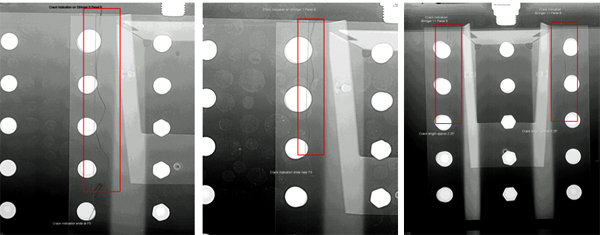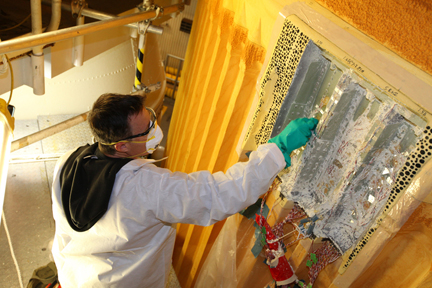More cracks found in Discovery's external tank (UPDATED)
Editor's note...
CBS News
KENNEDY SPACE CENTER, FL--Engineers examining the shuttle Discovery's external tank in the Vehicle Assembly Building have found four more small cracks in three structural ribs, or stringers, on the opposite side of the tank from the orbiter that could not be inspected at the launch pad. Four cracks on the shuttle side of the tank were repaired earlier, and it's not yet clear what, if any, additional work might be needed to develop "flight rationale" for another launch attempt as early as Feb. 3.
NASA managers met Thursday to review the on-going tank analysis and to discuss potential modifications to beef up the stringers to either side of the tank's massive booster-attachment thrust panels that experience the most stress during fueling and launch. All of the cracks found to date are located on stringers to either side of the left thrust panel.
But senior managers deferred any decisions about additional modifications pending further analysis of the newly discovered cracks. Shuttle Program Manager John Shannon told engineers to repair the cracks using the same techniques employed to fix the four found after the Nov. 5 launch try. That work will take two to three days to complete. Another review is planned for Monday.
If the modifications are ordered and no other major problems develop, NASA could roll Discovery back to launch pad 39A around Jan. 14 for work to ready the ship for another launch try Feb. 3.
But an on-going analysis of structural safety margins is not yet complete and it's not yet clear how the latest cracks might play into that discussion. Laboratory tests of stringers using mockups of external tank hardware to determine worst-case loads and failure modes are expected to begin next week.
NASA managers had hoped to launch Discovery on a space station resupply mission -- the orbiter's 39th and final flight -- on Nov. 1. But the launching was repeatedly delayed by relatively minor technical problems and finally, on Nov. 5, by a gaseous hydrogen leak in a 7-inch vent line quick-disconnect fitting on the side of the external tank.
During work to drain the tank, engineers spotted cracks in its foam insulation near the top of the intertank compartment that separates the tank's hydrogen and oxygen sections. When the damaged foam was removed, four cracks were found in two adjacent stringers near the tank's left-side booster attachment thrust panel, which helps carry the load during launch.
The cracks were repaired by splicing in replacement sections, along with so-called doublers to provide additional strength. But analysts have been unable to identify a single root cause explaining why the cracks formed in the first place, a key element in developing flight rationale showing the tank is structurally sound and able to withstand the rigors of fueling and launch.
To collect additional data, sophisticated X-ray-like scanners were used to examine the stringers on the side of the tank facing the shuttle -- the side engineers could access at the launch pad -- to make sure no additional cracks were present. None were found.
Dozens of strain gauges and temperature sensors then were attached to the tank for a full-scale fueling test Dec. 17. The sensor readings showed the stresses and strains experienced by the tank after it was loaded with more than a half-million gallons of supper-cold propellants matched up well with computer models as did the measured shrinkage of critical components. No sudden changes were noted in the stress data that might indicate additional stress-relief cracks.
To make the test as realistic as possible, the countdown was carried to the T-minus 31-second mark and the hydrogen and oxygen tanks were pressurized as they would be for a real launch. But pressurization had no major effect on the strain gauge data.
Based on data collected to that point, it appeared the cracks were the result of manufacturing issues that resulted in a build up of stress in the stringers in question that reached the breaking point when the tank was loaded with propellants Nov. 5. Overall, officials said, the data indicate the tank's design is robust and that the structure is as strong or stronger than initially believed.
But the shuttle's service gantry does not provide access to the back side of the external tank at the launch pad. To carry out additional X-ray inspections, Discovery was hauled back to the Vehicle Assembly Building Dec. 22. The four new cracks were spotted Wednesday on stringers six, seven and 11 on panel No. 6. Facing the left side of the tank, panel 6 is located to the left of the left-side booster thrust panel. The previously discovered cracks were located on panel No. 2, located on the right side of the left-side thrust panel.
All of the newly discovered cracks were smaller than the four found in the wake of the Nov. 5 launch attempt, measuring between 2.3 inches and 4 inches long.
Engineers already were considering the installation of special stiffeners on the 36 stringers -- nine to either side of the two thrust panels -- that experience the most stress during fueling and launch. All of the cracks discovered to date would be included in any such repair.
- Posted at 04:12 PM, 12/30/10: More cracks found in Discovery's external tank
- Updated at 05:15 PM, 12/30/10: Managers defer a decision on additional stringer modifications pending further analysis
CBS News
KENNEDY SPACE CENTER, FL--Engineers examining the shuttle Discovery's external tank in the Vehicle Assembly Building have found four more small cracks in three structural ribs, or stringers, on the opposite side of the tank from the orbiter that could not be inspected at the launch pad. Four cracks on the shuttle side of the tank were repaired earlier, and it's not yet clear what, if any, additional work might be needed to develop "flight rationale" for another launch attempt as early as Feb. 3.
 |
| The approximate locations of eight cracks found in structural ribs, or stringers, on the shuttle Discovery's external tank. (Photo: Spaceflight Now/Justin Ray) |
But senior managers deferred any decisions about additional modifications pending further analysis of the newly discovered cracks. Shuttle Program Manager John Shannon told engineers to repair the cracks using the same techniques employed to fix the four found after the Nov. 5 launch try. That work will take two to three days to complete. Another review is planned for Monday.
If the modifications are ordered and no other major problems develop, NASA could roll Discovery back to launch pad 39A around Jan. 14 for work to ready the ship for another launch try Feb. 3.
But an on-going analysis of structural safety margins is not yet complete and it's not yet clear how the latest cracks might play into that discussion. Laboratory tests of stringers using mockups of external tank hardware to determine worst-case loads and failure modes are expected to begin next week.
NASA managers had hoped to launch Discovery on a space station resupply mission -- the orbiter's 39th and final flight -- on Nov. 1. But the launching was repeatedly delayed by relatively minor technical problems and finally, on Nov. 5, by a gaseous hydrogen leak in a 7-inch vent line quick-disconnect fitting on the side of the external tank.
During work to drain the tank, engineers spotted cracks in its foam insulation near the top of the intertank compartment that separates the tank's hydrogen and oxygen sections. When the damaged foam was removed, four cracks were found in two adjacent stringers near the tank's left-side booster attachment thrust panel, which helps carry the load during launch.
The cracks were repaired by splicing in replacement sections, along with so-called doublers to provide additional strength. But analysts have been unable to identify a single root cause explaining why the cracks formed in the first place, a key element in developing flight rationale showing the tank is structurally sound and able to withstand the rigors of fueling and launch.
 |
| X-ray-like images showing four cracks on three stringers on the back side of the external tank. (Photo: NASA) |
To collect additional data, sophisticated X-ray-like scanners were used to examine the stringers on the side of the tank facing the shuttle -- the side engineers could access at the launch pad -- to make sure no additional cracks were present. None were found.
Dozens of strain gauges and temperature sensors then were attached to the tank for a full-scale fueling test Dec. 17. The sensor readings showed the stresses and strains experienced by the tank after it was loaded with more than a half-million gallons of supper-cold propellants matched up well with computer models as did the measured shrinkage of critical components. No sudden changes were noted in the stress data that might indicate additional stress-relief cracks.
 |
| A technician works at the site of cracks in two ribs, or stringers, in the shuttle Discovery's external tank that were discovered after a Nov. 5 launch attempt. (Photo: NASA) |
Based on data collected to that point, it appeared the cracks were the result of manufacturing issues that resulted in a build up of stress in the stringers in question that reached the breaking point when the tank was loaded with propellants Nov. 5. Overall, officials said, the data indicate the tank's design is robust and that the structure is as strong or stronger than initially believed.
But the shuttle's service gantry does not provide access to the back side of the external tank at the launch pad. To carry out additional X-ray inspections, Discovery was hauled back to the Vehicle Assembly Building Dec. 22. The four new cracks were spotted Wednesday on stringers six, seven and 11 on panel No. 6. Facing the left side of the tank, panel 6 is located to the left of the left-side booster thrust panel. The previously discovered cracks were located on panel No. 2, located on the right side of the left-side thrust panel.
All of the newly discovered cracks were smaller than the four found in the wake of the Nov. 5 launch attempt, measuring between 2.3 inches and 4 inches long.
Engineers already were considering the installation of special stiffeners on the 36 stringers -- nine to either side of the two thrust panels -- that experience the most stress during fueling and launch. All of the cracks discovered to date would be included in any such repair.